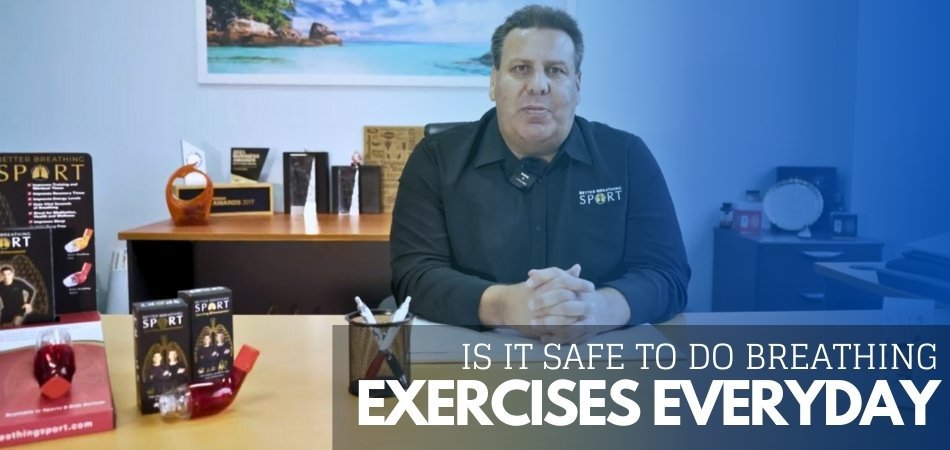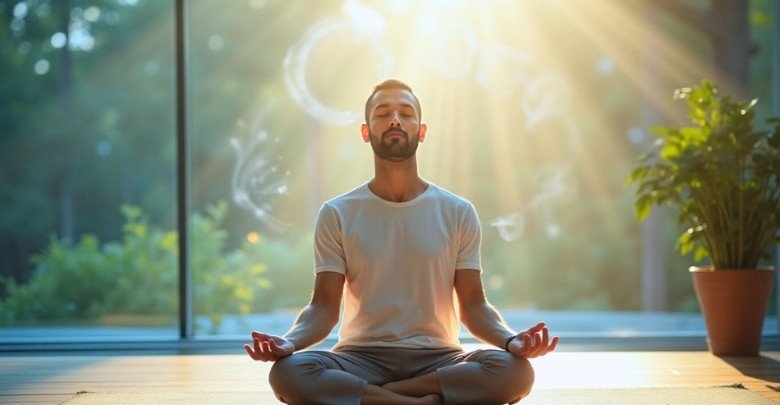Breathing exercises can help you feel calm, relaxed, and more focused. They are also good for your lungs and can help you sleep better. Doing them every day can make a big difference in how you feel, both in your body and your mind.
It’s a simple habit that anyone can try. But, is it safe to do breathing exercises everyday?
Yes, it is safe for most people to do breathing exercises every day. These exercises can lower stress, improve your breathing, and help you concentrate. But if you have heart or lung problems, you should talk to a doctor before trying harder types like holding your breath or fast breathing.
Want to know the best breathing exercises to try? Keep reading to find out!
Is it Safe to Do Breathing Exercises Everyday?
Yes, doing breathing exercises every day is safe for most people. It helps you feel calm, think better, and stay healthy. Just make sure you do it the right way and don’t overdo it. Now let’s look at how breathing exercises can help you in many ways.

Helps You Feel Calm
Sometimes school or homework can make you feel stressed. Deep breathing helps your body relax and your mind feel better. It tells your brain that everything is okay. You can feel more peaceful when you slow down your breath. It helps your heart beat slower too. This makes you feel less nervous during tough times.
Improves Focus
Your brain needs air to think and remember things. When you breathe well, more air goes to your brain. This helps you think faster and focus longer. If your mind feels full or tired, breathing can help clear it. It works like a small break to refresh your brain. This makes it easier to study or do homework.
Helps You Sleep Better
When you feel too tired or worried, breathing can help you sleep. It helps your body feel calm before going to bed. You can use breathing to relax at night. If thoughts keep you awake, try slow breathing. It makes your muscles loose and your mind quiet. This helps you fall asleep more easily.
Keeps Your Lungs Strong
Your lungs help you breathe all day. Breathing exercises make them work better and stay healthy. It’s like a gentle workout for your lungs. Some people use lung cleansing through breathing to keep their airways clean. This helps you breathe better during games or sports. Healthy lungs help you stay active and strong.
Gives You More Energy
Feeling sleepy during the day? Deep breathing can wake you up. It sends more air to your body and brain. You don’t always need snacks or tea to feel fresh. Just a few slow breaths can help. This gives you natural energy without anything extra.
Helps Control Emotions
If you feel angry, sad, or scared, breathing can help. It gives you a moment to feel calm. This helps you think before you act. You don’t have to keep emotions inside. Breathing lets them pass in a safe way. This makes you feel stronger and more in control.
Keeps Your Heart Healthy
Fast breathing can make your heart beat too fast. Slow breathing keeps your heart steady. This is good for your health and feelings. When your heart is calm, your body feels better too. You feel less tired and more relaxed. It helps you stay happy and healthy.
Do Breathing Exercise Devices Really Work?
Yes, breathing exercise devices do work if you use them the right way every day. These tools help make your lungs stronger by training your breathing muscles. People use them to breathe better during sports, studies, or even when feeling tired. They are good for students, athletes, and anyone who wants to improve their breathing.
Some tools work better when you use them often and follow simple steps. Many athletes use the Better Breathing Sport device to help with breathing during games or training. These devices don’t replace good habits, but they can support better breathing over time. Always take it slow, use them correctly, and ask someone for help if you’re unsure.
10 Minutes Daily Breathing Exercise Safely: Step by Step Process
Doing breathing exercises for just 10 minutes every day can make you feel calm and focused. It’s a simple way to relax your body and clear your mind. No tools are needed-just some quiet time and a quiet place. Here’s a step by step guide to help you complete the 10 minutes daily breathing exercise safely:

Step 1: Find a Quiet and Comfortable Spot
Look for a place where no one will disturb you. Sit on the floor or a chair with your back straight. Keep your hands on your lap and close your eyes gently. Take a moment to feel relaxed and ready.
Step 2: Start with Normal Breathing
Breathe in and out slowly like you normally do. Try to notice how your chest moves when you breathe. Don’t change anything yet—just feel your breath. This helps your body settle down before you begin.
Step 3: Inhale Deeply Through the Nose
Now breathe in slowly through your nose for four full seconds. Let the air fill your chest and belly. Count in your mind as you breathe in. You should feel your body gently rising.
Step 4: Hold Your Breath for a Few Seconds
After you breathe in, hold your breath for four seconds. Don’t tighten your body—stay relaxed and still. Focus your mind on your breath during this short hold. It helps train your lungs and calm your brain.
Step 5: Breathe Out Slowly Through the Mouth
Let the air out slowly through your mouth for four seconds. Feel your shoulders drop as you exhale. Keep your face and body loose while you breathe out. This helps release tension from your muscles.
Step 6: Repeat the Breathing Cycle
Do this slow breathing cycle five to six times. Always breathe in through your nose and out through your mouth. Try to stay calm and keep your breath smooth. If your mind wanders, bring your focus back to breathing.
Step 7: End with a Few Normal Breaths
After the last round, return to normal breathing. Open your eyes and stretch your hands slowly. Take a deep breath and smile—you’ve finished your session. You should feel more peaceful and ready for the day.
Who Should Be Careful with Breathing Exercises?
Breathing exercises are good for many people, but some need to be careful while doing them. Not every breathing method is right for everyone. Some people may feel unwell if they do the wrong kind. It’s always smart to ask an adult or doctor if you’re unsure.

People with Heart Problems
Without consulting a doctor, people with heart problems should not try strong or fast breathing. Some breathing styles make the heart beat faster. This can cause chest pain, dizziness, or feel scary. It’s better to start slow and stay safe while breathing.
People with Asthma or Lung Issues
Breathing exercises that need deep or fast breaths can be hard for those with asthma or weak lungs. These may lead to coughing, chest tightness, or shortness of breath during practice. Some people may get the necessary advantages of daily breathing devices, which can support lung strength and safer breathing. Always ask a doctor before trying any new technique or tool.
People with Anxiety or Panic Attacks
Some strong breathing types can make panic or anxiety feel worse. Holding your breath too long can feel uncomfortable. Choose calm and slow breathing that helps you feel safe and okay. If something feels wrong, stop and tell someone you trust.
People Healing After Surgery
After a surgery, the body needs rest, so don’t do deep breathing too soon. It may hurt or feel tight. Always check with a doctor before starting any breathing plan. Light and short breathing is best during healing time.
People Who Feel Dizzy Often
Fast breathing can make some people feel dizzy or weak. If your blood pressure is low, this can be risky. Sit down and take slow breaths to stay steady and safe. Never force your breath if it doesn’t feel right.
How to Make Breathing Exercises a Daily Habit?
Breathing exercises can help you feel calm, focused, and fresh every day. But it’s not always easy to remember to do them. With some simple tricks, you can make it a daily habit. These tips will help you stay regular and enjoy your breathing time:
- Choose the same time each day: Pick a time that fits your day well, like after waking up or just before going to sleep at night.
- Use a daily alarm or reminder: Set a phone alarm to remind you, so you won’t forget even when your day feels busy or full.
- Start with short breathing time: You don’t need to start big—just try five minutes each day and slowly do more when you feel ready.
- Find a quiet place to sit: Go to a quiet corner where no one bothers you, and you can sit peacefully to do your breathing.
- Add it to another daily habit: Do breathing right after brushing your teeth or before reading, so it becomes a part of your routine.
- Keep a small record or chart: Use a notebook or app to tick off each day, which helps you feel good and stay on track.
- Try different breathing methods: You can use simple and fun breathing styles, so it doesn’t get boring and stays easy to enjoy.
Frequently Asked Questions about Daily Breathing Exercises
Breathing exercises are easy, helpful, and safe for most people when done daily. But many students and beginners still have questions about doing them the right way. Below are some useful FAQs with clear and simple answers.
Can Breathing Exercises Help With Exam Stress?
Yes, breathing exercises can calm your mind and reduce exam stress. They help slow your heartbeat and clear your thoughts, making it easier to stay focused and relaxed during study or test time. Practice before exams for best results.
Is It Okay To Do Breathing Exercises Right After Eating?
It’s better to wait 15–30 minutes after eating before doing breathing exercises. Full stomachs can make deep breathing feel uncomfortable. Choose a calm time between meals for better comfort and focus during your breathing practice.
Should I Do Breathing Exercises Before Or After Exercise?
Breathing exercises work well both before and after physical activity. Before exercise, they prepare your lungs. Afterward, they help your body relax and recover. Pick the time that feels most helpful for your routine.
Can Breathing Exercises Improve My Voice Or Speech?
Yes, breathing exercises can help improve voice control and speech. They strengthen breathing muscles and help manage airflow. This is useful for speaking clearly, singing, or reading out loud with more confidence and better control.
Do I Need A Special Tool For Daily Breathing Exercises?
No special tool is needed for most breathing exercises. Just a quiet place and a few minutes are enough. However, some people use simple tools to guide their breath and improve lung power with regular practice.
Can I Do Breathing Exercises While Sitting At School?
Yes, you can do short breathing exercises while sitting in class. Quiet breathing helps calm your mind without making noise. Just sit straight, breathe slowly, and focus for a minute during breaks or before tests.
Are Breathing Exercises Safe During Headaches?
Gentle breathing can help with mild headaches. It brings in fresh air and helps relax tense muscles. But if you feel dizzy or worse, it’s best to stop and rest. Always listen to your body.
Can Breathing Exercises Help With Tiredness During The Day?
Yes, breathing can boost your energy. Deep breaths bring more oxygen to your body and help you feel fresh again. It’s a great way to feel awake without snacks or caffeine, especially after long school hours.
Is It Safe To Do Breathing Exercises While Lying Down?
Lying down is fine for breathing practice if you stay relaxed and breathe easily. Many people do this before they sleep. Just keep your back straight and body loose for better results while lying comfortably on your bed or mat.
Can Breathing Exercises Be Done With Meditation Or Music?
Yes, adding music or meditation can make breathing exercises more relaxing. Soft music helps you focus and stay calm. It creates a peaceful space, especially if your mind feels busy or full of thoughts during the day.
Final Thoughts
Breathing exercises are an easy way to feel calm, think better, and stay healthy every day. They can help you sleep well, feel less stressed, and stay focused during your studies. If you are thinking is it safe to do breathing exercises everyday, the answer is yes—it’s safe for most people.
Just take it slow and talk to a doctor if you have heart or lung problems. Doing it daily doesn’t take much time, and even a few minutes can make a big difference. With regular practice, breathing exercises can help you feel better in both your body and your mind.






